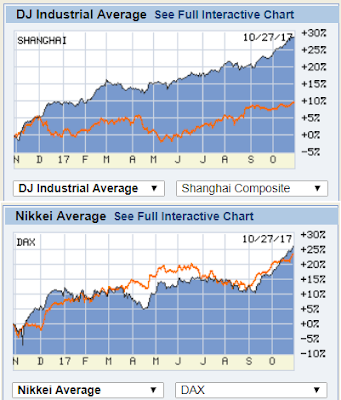I like the development in the new German government. #1
CDU getting closer with #4 FDP (Free Democratic Party) in climate and energy
policies while potential partner #5 Greens go more idiotic and watermelon-ic
(green outside, red inside) in demanding zero coal power. The Greens have more
commonality with #2 SDP and #6 Linke (commies). CDU is correct -- if they
follow the Greens for the sake of coalition-majority, #3 AfD will greatly
benefit and further expand as AfD is explicitly anti-renewables alarmism and
cronyism. Germany having 3rd highest electricity prices in the world might move
to 2nd or 1st if the Greens-SDP agenda will prevail.
https://www.thegwpf.com/climate-policy-threatens-to-crash-german-coalition-negotiations/
"Kellner reiterated the Greens’ position that Germany should quickly close coal-fired power stations to help fight climate change, a position resisted by the other parties."
October 26, 2017.
https://www.reuters.com/article/us-germany-politics/german-coalition-talks-stumble-on-migration-climate-idUSKBN1CV1FZ
https://www.thegwpf.com/climate-policy-threatens-to-crash-german-coalition-negotiations/
“If coal plants are closed down in Eastern Germany and thousands of workers are made redundant, very soon 30% of voters will support the Alternative für Deutschland (AfD),” Laschet warned. ... Prime Minister Laschet announced that he would not make substantial concessions: “If push comes to shove we will have to crash the talks.” He said that environmental policy was a bigger hurdle for the negotiations than immigration policy: “The latter is easier to settle than the closure of power stations.”
(translated to English by The GWPF)
"Kellner reiterated the Greens’ position that Germany should quickly close coal-fired power stations to help fight climate change, a position resisted by the other parties."
October 26, 2017.
https://www.reuters.com/article/us-germany-politics/german-coalition-talks-stumble-on-migration-climate-idUSKBN1CV1FZ
"While all parties agreed in principle this week
that they want to uphold the Paris climate accord, the FDP is pressing for a
commitment to curb government measures to promote renewable energy, which help
make German power prices the second-highest in the European Union after
Denmark’s.
“We certainly have to reduce carbon dioxide,” the FDP’s
Suding said. “In Germany, this is much more expensive than in other countries
and we have to find a way to reduce CO2 emissions more cheaply. Of course,
there won’t be a complete phase-out of coal by 2030.”
October 27, 2017.
"According to Lindner (FDP):
The project of the century Energiewende [transition to
green energies] has failed. None of the agreed targets will be reached. Climate
protection is stalled, energy prices are rising and they are burdening us as
electricity consumers, just as they are the industry and middle class. And not
least of all it is becoming increasingly difficult to guarantee a secure power
supply during the winter months.”
http://notrickszone.com/2017/09/29/germanys-green-energy-project-close-to-death-eeg-feed-in-act-has-failed-has-to-go/#sthash.ZAheNnnr.RsV59Dyz.dpbs
http://notrickszone.com/2017/09/29/germanys-green-energy-project-close-to-death-eeg-feed-in-act-has-failed-has-to-go/#sthash.ZAheNnnr.RsV59Dyz.dpbs
It is good that both CDU/CSU and FDP are jointly resisting the
deindustrialization goal of the Greens. One reason why AfD rocketed high to
nearly 13% of the votes despite being created only 4 years ago is on the energy
mini-suicide of the watermelon groups.
---------------
---------------
See also:
Energy 99, Germany's FDP questioning or ditching Energiewende, October 04, 2017
Energy 100, Bjorn Lomborg on World energy mix, October 19, 2017
Energy 101, Disinformation and fake stories by the watermelon movement, October 22, 2017
























